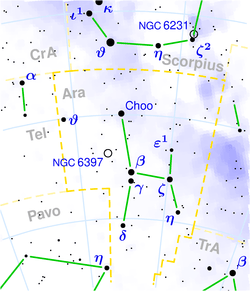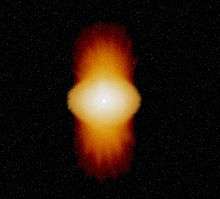Alpha Arae
Alpha Arae, Latinized from α Arae, is the second brightest star in the southern constellation of Ara. With an average apparent visual magnitude 2.93,[2] it is readily visible to the naked eye from the southern hemisphere. This star is close enough to the Earth that its distance can be estimated using parallax data collected during the Hipparcos mission. It is around 270 light-years (83 parsecs) away, with a 7% margin of error. The visual magnitude of the star is diminished by 0.10 magnitudes as a result of extinction from intervening gas and dust.[9]
 α Arae (Choo) in the constellation Ara. | |
| Observation data Epoch J2000.0 Equinox J2000.0 (ICRS) | |
|---|---|
| Constellation | Ara |
| Right ascension | 17h 31m 50.49153s[1] |
| Declination | −49° 52′ 34.1220″[1] |
| Apparent magnitude (V) | 2.93[2] (2.76 to 2.90)[3] |
| Characteristics | |
| Spectral type | B2 Vne[4] |
| U−B color index | −0.72[2] |
| B−V color index | −0.16[2] |
| R−I color index | −0.24[3] |
| Variable type | BE[5] |
| Astrometry | |
| Radial velocity (Rv) | 0[6] km/s |
| Proper motion (μ) | RA: −33.27[1] mas/yr Dec.: −67.22[1] mas/yr |
| Parallax (π) | 12.20 ± 0.85[1] mas |
| Distance | 270 ± 20 ly (82 ± 6 pc) |
| Absolute magnitude (MV) | −1.72[7] |
| Details | |
| Mass | 9.6[8] M☉ |
| Radius | 4.5[9] R☉ |
| Luminosity (bolometric) | 5,800[8] L☉ |
| Surface gravity (log g) | 3.99[9] cgs |
| Temperature | 18,044[9] K |
| Rotational velocity (v sin i) | 375[10] km/s |
| Other designations | |
| Database references | |
| SIMBAD | data |
Properties

Alpha Arae has a stellar classification of B2 Vne,[4] indicating that it is a massive B-type main sequence star. The 'n' notation in the suffix indicates that the absorption lines in the star's spectrum appear spread out and nebulous because of the Doppler effect from rapid rotation. The measured projected rotational velocity has been measured as high as 375 km s−1.[10] Meilland et al. (2007) estimate the pole of the star is inclined by 55° to the line of sight, yielding an equatorial azimuthal velocity of 470 km s−1. This is close to the critical velocity where the star would start to break up.[8] The rapid rotation is causing a pronounced equatorial bulge of about 2.4–2.7 times the polar radius.[9]
It is a Be star, as indicated by the 'e' notation in the star's classification. This indicates that emission lines are observed in the spectrum, which is coming from a disk of material ejected from the star because of its rapid rotation.[14] In 2003 and 2005, Alpha Arae was observed by infrared interferometry, using the MIDI and AMBER instruments at the VLT Interferometer. The results, published in 2005 and 2007, appear to show that Alpha Arae is surrounded by a dense equatorial disk of material in Keplerian (rather than uniform) rotation, and that it is losing mass by a polar stellar wind with a terminal velocity of approximately 1,000 km/s. There is also some evidence that Alpha Arae is orbited by a companion at 0.7 AU.[8][15]
This star is around 9.6 times as massive as the Sun,[8] and has an average of 4.5 times its radius.[9] It is 5,800 times as luminous as the Sun,[8] its energy emitted from its outer envelope at an effective temperature of 18,044 K.[9] This heat gives Alpha Arae the blue-white hue that is characteristic of B-type stars. It is a variable star with a magnitude that varies between 2.76m and 2.90m.[3][11] The General Catalogue of Variable Stars classifies it only as BE, indicating that it is a variable Be star but not obviously a Gamma Cassiopeiae variable.[5] The International Variable Star Index defines it as GCAS + LERI, showing both rapid periodic variation and slow irregular eruptions.[16]
Alpha Arae has a visual companion star, CCDM J17318-4953B, located approximately 50 arcseconds away along a position angle of 168°, with an apparent visual magnitude of about 11.[12] The two stars appear close to each other by coincidence and are not physically close in space.[3]
In culture
With β and σ Ara it forms the Chinese asterism Choo (pinyin: chǔ, 杵), "pestle" in traditional Chinese astronomy. It was the second star of Choo (杵二), but R. H. Allen used the name Choo for this star only.[13] Patrick Moore lists Choo as a proper name for this star in his star catalogue of the constellation Ara.[17] This name is also given the French spelling Tchou. There is another Choo in the constellation Pegasus.
In Chinese, 杵 (Chǔ), meaning Pestle, refers to an asterism consisting of α Arae, σ Arae and β Arae.[18] Consequently, the Chinese name for α Arae itself is 杵二 (Chǔ èr, English: the Second Star of Pestle).[19]
See also
- Traditional Chinese star names in Ara
- Traditional Chinese star names in Pegasus
References
- van Leeuwen, F. (November 2007), "Validation of the new Hipparcos reduction", Astronomy and Astrophysics, 474 (2): 653–664, arXiv:0708.1752, Bibcode:2007A&A...474..653V, doi:10.1051/0004-6361:20078357
- Feinstein, A.; Marraco, H. G. (November 1979), "The photometric behavior of Be Stars", Astronomical Journal, 84: 1713–1725, Bibcode:1979AJ.....84.1713F, doi:10.1086/112600
- HR 6510, database entry, The Bright Star Catalogue, 5th Revised Ed. (Preliminary Version), D. Hoffleit and W. H. Warren, Jr., CDS ID V/50. Accessed on line November 26, 2008.
- Houk, Nancy (1978), "Michigan catalogue of two-dimensional spectral types for the HD stars", Ann Arbor : Dept. of Astronomy, Ann Arbor: Dept. of Astronomy, University of Michigan, 2, Bibcode:1978mcts.book.....H
- alf Ara, database entry, The combined table of GCVS Vols I-III and NL 67-78 with improved coordinates, General Catalogue of Variable Stars, Sternberg Astronomical Institute, Moscow, Russia. Accessed on line November 26, 2008.
- Evans, D. S. (June 20–24, 1966). "The Revision of the General Catalogue of Radial Velocities". In Batten, Alan Henry; Heard, John Frederick (eds.). Determination of Radial Velocities and their Applications, Proceedings from IAU Symposium no. 30. Determination of Radial Velocities and their Applications. 30. University of Toronto: International Astronomical Union. p. 57. Bibcode:1967IAUS...30...57E.
- Anderson, E.; Francis, Ch. (2012), "XHIP: An extended hipparcos compilation", Astronomy Letters, 38 (5): 331, arXiv:1108.4971, Bibcode:2012AstL...38..331A, doi:10.1134/S1063773712050015.
- Meilland, A.; et al. (March 2007), "First direct detection of a Keplerian rotating disk around the Be star α Arae using AMBER/VLTI", Astronomy and Astrophysics, 464 (1): 59–71, arXiv:astro-ph/0606404, Bibcode:2007A&A...464...59M, doi:10.1051/0004-6361:20064848. See Tables 1 and 4 for parameters of the star, circumstellar disk, and polar winds.
- Meilland, A.; Stee, Ph.; Chesneau, O.; Jones, C. (October 2009), "VLTI/MIDI observations of 7 classical Be stars", Astronomy and Astrophysics, 505 (2): 687–693, arXiv:0908.1239, Bibcode:2009A&A...505..687M, doi:10.1051/0004-6361/200911960
- Bernacca, P. L.; Perinotto, M. (1970), "A catalogue of stellar rotational velocities", Contributi Osservatorio Astronomico di Padova in Asiago, 239 (1), Bibcode:1970CoAsi.239....1B
- V* alf Ara -- Eruptive variable Star, database entry, SIMBAD. Accessed on line November 26, 2008.
- Entry 17318-4953, The Washington Double Star Catalog Archived 2012-07-08 at Archive.today, United States Naval Observatory. Accessed on line November 26, 2008.
- Allen, R. H. (1963), Star Names: Their Lore and Meaning (Reprint ed.), New York, NY: Dover Publications Inc., p. 63, ISBN 0-486-21079-0
- To Be or Not to Be: Is It All About Spinning?: VLTI Discerns How Matter Behaves in Disc Around a Be Star Archived 2008-12-01 at the Wayback Machine, ESO press release 35/06, September 20, 2006. Accessed on line December 12, 2008.
- Chesneau, O.; Meilland, A.; Rivinius, T.; Stee, Ph.; Jankov, S.; Domiciano de Souza, A.; Graser, U.; Herbst, T.; Janot-Pacheco, E.; Koehler, R.; Leinert, C.; Morel, S.; Paresce, F.; Richichi, A.; Robbe-Dubois, S. (2005). "First VLTI/MIDI observations of a Be star: Alpha Arae". Astronomy and Astrophysics. 435 (1): 275–287. arXiv:astro-ph/0501162. Bibcode:2005A&A...435..275C. doi:10.1051/0004-6361:20041954.
- Watson, C. L. (2006). "The International Variable Star Index (VSX)". The Society for Astronomical Sciences 25th Annual Symposium on Telescope Science. Held May 23–25. 25: 47. Bibcode:2006SASS...25...47W.
- Moore, P. (1983), The Guinness Book of Astronomy Facts and Feats (Second ed.), Middlesex: Guinness Superlatives Ltd, p. 187, ISBN 0-85112-291-4
- (in Chinese) 中國星座神話, written by 陳久金. Published by 台灣書房出版有限公司, 2005, ISBN 978-986-7332-25-7.
- (in Chinese) 香港太空館 - 研究資源 - 亮星中英對照表 Archived 2009-09-29 at the Wayback Machine, Hong Kong Space Museum. Accessed on line November 23, 2010.